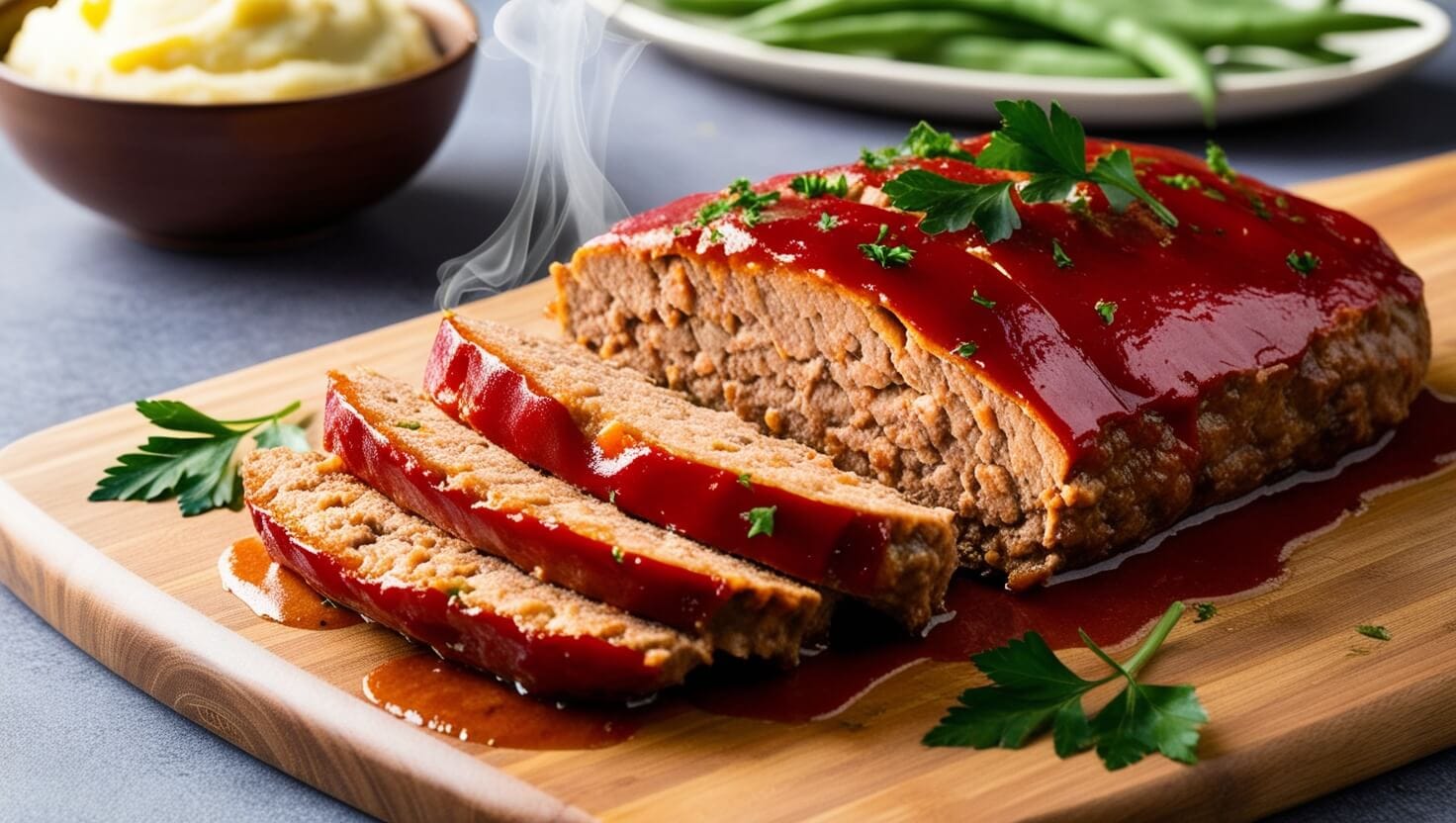Meatloaf is a classic comfort food. Its hearty flavor and versatility make it a favorite, bringing families together at the dinner table and offering a timeless appeal. Whether you prefer it with a tangy glaze, packed with vegetables, or as part of a nostalgic family recipe, it’s a dish with universal charm. However, one common issue many home cooks face is meatloaf still pink inside, even after following the recipe carefully. Despite using the best ingredients and intentions, this unexpected outcome can leave you puzzled and searching for answers.
One of the most common concerns for home cooks is meatloaf still pink inside. You slice into a seemingly perfectly baked loaf, only to find the center undercooked and pink. This can be both confusing and frustrating, especially if you’ve followed the recipe to the letter. Is it safe to eat? Did you make a mistake during preparation or cooking?
Understanding why meatloaf stays pink inside is key to alleviating these concerns. It’s not always a sign of undercooking and is often due to harmless factors like chemical reactions, ingredient choices, or the preparation method. This article will dive deep into the science and techniques behind meatloaf cooking, explaining why your meatloaf might still be pink inside, how to cook it safely, and how to troubleshoot common kitchen issues.
Table of Contents
Why Is My Meatloaf Still Pink inside?
If you’ve ever cut into your meatloaf and noticed a pink hue, it’s natural to wonder whether it’s undercooked or unsafe. The pinkness might not mean it’s raw; several factors can contribute to this outcome.
1. Chemical Reactions During Cooking to explain why the Meatloaf Still Pink Inside
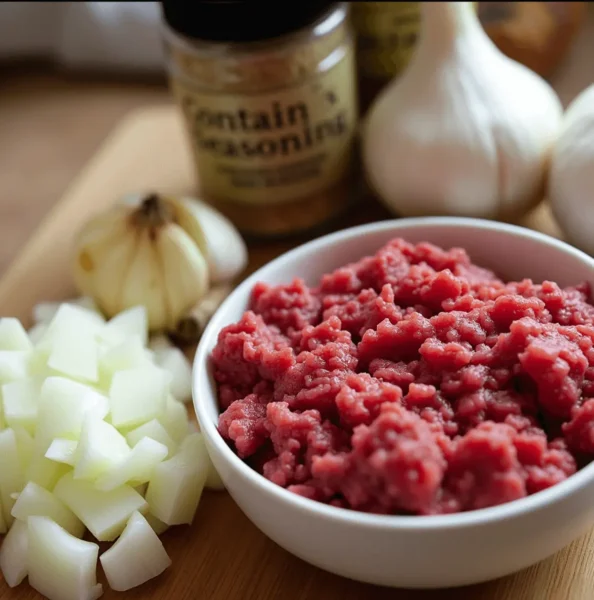
Cooking meat involves chemical reactions that can cause it to turn pink, even when it has reached a safe internal temperature. Certain ingredients, like nitrites and nitrates, can cause this effect, and researchers have found these compounds in many instances.
- Onions and other vegetables.
- Cured meats, like bacon or sausage, are delicious.
- Seasoning blends or store-bought meatloaf mixes.
When these compounds interact with myoglobin (a protein in meat), they can produce a persistent pink color. This reaction is similar to cured meats, like ham or smoked sausage.
For more details about nitrite interactions, check out this USDA guide on meat safety.
2. Cooking Method and Temperature to avoid that Meatloaf Still Pink Inside
Using the wrong cooking temperature or method can leave your meatloaf pink in the middle. Slow cooking or baking at too low a temperature can prevent the meat’s proteins from fully denaturing, which is essential to reduce pinkness.
- Oven temperature: Cook at 350°F for even heat. A lower temp may not cook the inside properly.
- Thick or dense meatloaf: The thicker the loaf, the longer the heat penetrates the center, potentially leaving it pink.
Using a thermometer is crucial here (more on that below). Check out this meat temperature guide for safe cooking levels.
3. Type of meat used.
Different types of meat affect the final color of your meatloaf. Ground beef, pork, and turkey behave differently when exposed to heat.
- Ground beef often retains a slightly pink hue, especially if it is high-quality.
- Ground turkey might also look pink due to its natural pigments, even when fully cooked.
- Mixed meats (e.g., beef and pork) can vary in texture and color.
If you’re looking to experiment with flavors, consider trying this smoked meatloaf recipe, which introduces a delicious twist to traditional meatloaf.
How to Ensure Meatloaf Is Fully Cooked
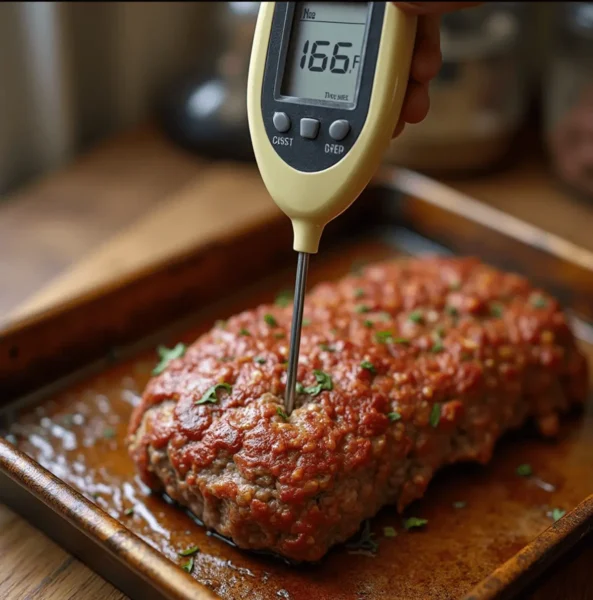
Knowing when your meatloaf is fully cooked is essential for ensuring both safety and flavor. Properly cooked meatloaf must be safe and tasty. It must be thoroughly cooked to kill harmful bacteria, but it must also be moist and flavorful. Let’s explore the most reliable methods for determining Doneness and why they matter.
1. Importance of Using a Meat Thermometer
A meat thermometer is the most reliable way to check if your meatloaf is fully cooked. A thermometer gives an accurate reading of the internal temperature. Visual cues can be misleading, so do not rely on them.
- Insert the thermometer into the thickest part of the meatloaf. Avoid air pockets and contact with the baking pan, as these can skew the reading.
- The safe internal temperature for meatloaf made with ground beef or pork is 160°F. This kills harmful bacteria, like E. coli and Salmonella, and prevents overcooking the meat.
- Cook poultry meatloaf, like turkey or chicken, to 165°F. These meats need a higher temperature to be safe.
A thermometer removes the guesswork and ensures your meatloaf is perfectly cooked and juicy. A digital meat thermometer is a worthwhile investment for this and other recipes.
2. Safe Internal Temperatures for Different Meats
Different types of meat must have different cooking temperatures to ensure they’re safe to eat. Here’s a quick reference for common meatloaf ingredients:
- Ground beef or pork: 160°F
- Ground turkey or chicken: 165°F
- Mixed meats (e.g., beef and pork): Follow the higher temperature guideline for safety, typically 165°F.
This range in cooking temperatures shows the need for a good thermometer. It must be used consistently.
3. Visual Cues to Check Doneness
A thermometer is the gold standard, but visual cues can help. They can guide you in checking whether your meatloaf is done.
- Crust: The outer layer of the meatloaf should be browned and slightly crispy, indicating it has been exposed to enough heat.
- Texture: When sliced, the interior should be firm and hold together well without crumbling or appearing mushy.
- Juices: When you cut into the meatloaf, the juices should run clear, not pink or red. Pink juices can mean undercooked meat, especially if paired with a mushy texture.
Yet, visual indicators can sometimes be deceptive. For instance, chemical reactions with onions or garlic can keep the center pink, even when fully cooked. This is why combining visual cues with a thermometer is the best approach.
4. The Role of Resting Time
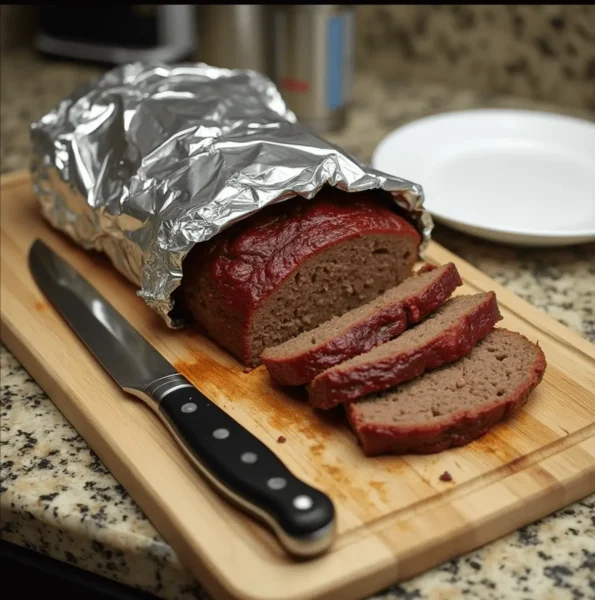
After your meatloaf reaches the proper internal temperature, it must rest for 10 to 15 minutes before slicing. This resting period redistributes the juices within the meatloaf, making every slice extra smooth and flavorful. Skipping this step can cause a drier texture, even though the meat changed into cooked perfectly.
For additional tips on achieving the perfect texture and flavor, read this guide on meatloaf seasoning.
Common Mistakes That Lead to Meatloaf Still Pink Inside.
Even with the right tools and techniques, specific errors can still result in pink meatloaf. Here are the most common mistakes to avoid:
1. Undercooking
Misjudging cooking times is a leading cause of pink meatloaf. For a 1 lb loaf, cooking at 350°F for 35 to 45 minutes should suffice, but larger loaves need more time. Use this as a guide:
- 1 lb: 35–45 minutes.
- 2 kg: 55–70 minutes.
- 3 kg: 80–90 minutes.
2. Using Too Many Eggs or Wet Ingredients
Eggs act as a binder in meatloaf, but adding too many eggs or wet ingredients like milk or ketchup can lead to excess moisture. This moisture can trap heat and delay the internal cooking process, leaving parts of the meatloaf pink and soft.
Learn how to avoid similar pitfalls when smoking meats by reading this article on preventing dry smoked meat.
Fixing a Pink Meatloaf
If you’ve already cooked your meatloaf and it’s pink inside, don’t panic! Here are some ways to salvage it:
1. Adjust Cooking Times
- Return the loaf to the oven and cook for another 5 to 10 minutes at 375°F.
- Cover with aluminum foil to prevent the exterior from drying out.
2. Add Structure
If the pinkness is due to too much moisture, consider:
- Serving smaller slices and reheating them individually.
- Adding a sauce or glaze to balance the texture.
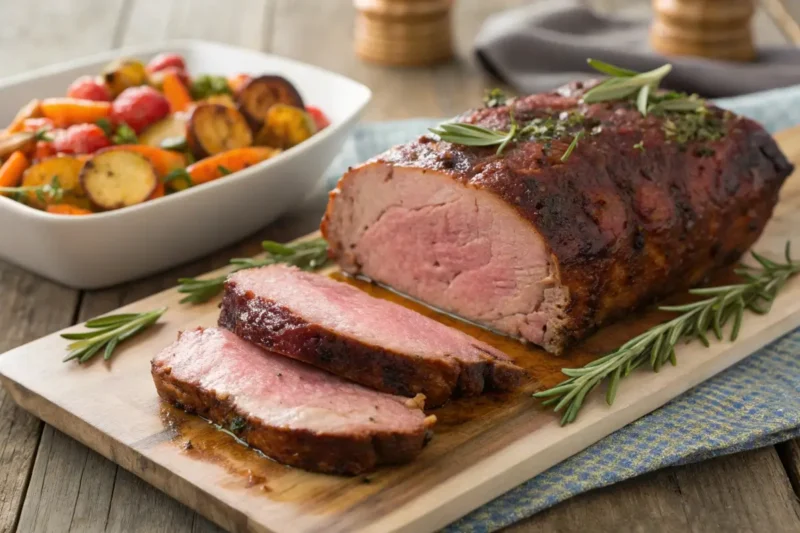
FAQs About why Meatloaf Still Pink Inside
Is Pink Meatloaf Always Unsafe to Eat?
Not necessarily! The pink in meatloaf often sparks worry, but it only sometimes means it is undercooked or unsafe to eat. If your meatloaf’s internal temperature is 160°F for beef or pork or 165°F for poultry, it is safe to eat, regardless of color. A properly calibrated meat thermometer is the most reliable tool to ensure safety. If you lack a thermometer or doubt your dish’s safety, it’s best to be cautious. Cook the meatloaf for a few more minutes. It’s vital to cook food well when serving children, pregnant women, or those with weak immune systems.
It is worth noting that visual cues, like the color of the meat, are not always reliable indicators of Doneness. Several factors can keep your meatloaf pink even when fully cooked, so relying only on appearance may cause overcooking and a dry result.
What Causes to Meatloaf Still Pink Inside?
Several factors can cause your meatloaf to stay pink, even after cooking. These include:
- Pinkness often results from harmless chemical reactions during cooking. Onions, garlic, celery, and some seasoning blends can affect meat. They contain nitrates or nitrites. They can interact with the meat’s myoglobin protein, locking in a pink hue. This reaction is like what happens in cured meats, like ham or smoked sausage, and doesn’t mean the meatloaf is unsafe.
- One cause of pink meatloaf is undercooking. If the heat doesn’t reach the center of the loaf, the inside can remain pink. This can happen due to a low oven temperature, a thick loaf, or a short cooking time. Uneven heat distribution in the oven or overly dense meat mixtures can exacerbate this issue.
- Specific Types of Meat The type of ground meat you use can also play a role in the pink color. For example:
- Turkey and chicken meatloaf often retain a pink hue even when fully cooked due to the natural color of the poultry muscle fibers.
- Grass-fed or high-quality meats may be pinker than conventional ground beef, even when cooked to a safe temperature.
To avoid confusion, always check Doneness with a thermometer. Adjust your recipe for your meat’s specific traits.
Master the Art of Cooking Meatloaf: Say Goodbye to Meatloaf Still Pink Inside and Hello to Perfection
A pink center in your meatloaf doesn’t have to be a source of stress. It’s easy to assume that pinkness means undercooking. But, it’s often due to harmless factors. These include chemical reactions between ingredients and the natural properties of some meats. Knowing the science of cooking temperatures and ingredient roles, you can take the guesswork out of cooking meatloaf. Using essential tools, like a meat thermometer, will help. You’ll serve a perfectly cooked dish every time.
One of the most important takeaways is recognizing the value of a thermometer. Unlike visual cues, which can be misleading, a thermometer is accurate. It confirms your meatloaf has reached a safe internal temperature: 160°F for ground beef or pork and 165°F for poultry. This ensures that your dish is delicious and safe to eat, no matter how it looks.
Fine-Tune Your Meatloaf: Tips for Perfect Texture, Flavor, and Confidence in the Kitchen
Consistent cooking comes from knowing how factors affect your meatloaf. Adjusting oven temperatures, loaf thickness, and ingredient amounts can greatly affect the result. If your meatloaf has a pink hue due to nitrates in onions or moist textures due to too many eggs, these tips will help you fix your recipe.
Cooking meatloaf is a process of learning and experimentation. As you try new techniques, you’ll gain confidence and improve with each attempt. Feel free to tweak your recipe or cooking methods to suit your preferences. These tips will help you. They will help you make juicy, flavorful, and perfectly cooked meatloaf. Whether you’re a beginner or an experienced cook, you’ll worry less and feel more satisfied.
So, the next time you make meatloaf, approach the process with a clear understanding and a thermometer. Experiment with your ingredients, adjust your methods as needed, and enjoy the rewards of a well-cooked meal. Take control of the cooking. Soon, you’ll master a safe, tender meatloaf. It will be worth sharing with family and friends. You’ve got this! now create your perfect meatloaf!
Understanding the science behind cooking meatloaf eliminates guesswork and frustration. Use a thermometer, experiment with different techniques, and explore new recipes to find what works best for you. If you’re new to meatloaf making or looking to refine your skills, check out this herb-roasted turkey recipe or the Shocking Answer for Meatloaf Still Pink Inside for inspiration in creating flavorful dishes.
By following these tips, you can confidently prepare meatloaf that is not only safe but also moist and delicious every time.

